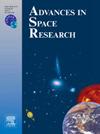利用太阳帆跟踪绕小行星移位轨道的航天器的动力学与控制
IF 2.8
3区 地球科学
Q2 ASTRONOMY & ASTROPHYSICS
引用次数: 0
摘要
本研究调查了航天器通过现实太阳帆实现的近地小行星移位轨道,其性能基于现有技术的低距离。与使用传统推进器相比,在两个主要限制条件下使用现实太阳帆实现短距离位移轨道的难度更大:力的限制和位置的限制。首先,太阳帆产生的太阳辐射压力(SRP)受太阳帆特性和太阳光方向的限制。因此,利用具有实际性能的太阳帆,分析研究了在小行星周围低距离平衡点维持位移轨道的可行性。结果表明,位移轨道的平衡点是可以达到的。其次,太阳帆的使用也受到航天器位置的限制。在没有阳光的日食区域无法产生太阳帆力;具体而言,在位移距离较小的位移轨道上,位置限制更为明显。为解决这一难题,研究了利用太阳帆实现位移轨道的航天器动力学和控制,并提出了在日食区域外进行轨道转移的方法。数值模拟显示,利用太阳帆,航天器可以在不进入日食区的情况下保持位移轨道。此外,利用太阳帆,航天器可以在两个平衡点之间实现轨道转移,而不会进入日食区。还研究了主小行星非球形形状的影响。结果表明,当主小行星为非球形时,所提出的方法可以在有限的时间跨度内维持一个与参考状态误差小于10%的位移轨道。本文章由计算机程序翻译,如有差异,请以英文原文为准。
Dynamics and control for spacecraft tracking a displaced orbit around an asteroid exploiting solar sail
This study investigates the displaced orbit around a near-Earth asteroid for spacecraft achieved via a realistic solar sail with a performance based on the existing technology in a low distance. Using the realistic solar sail to achieve the displaced orbit with a short displaced distance is more difficult compared with using a traditional thruster under two main limitations: The force limitation and the position limitation. Firstly, the solar radiation pressure (SRP) force generated by the solar sail is limited by the solar sail’s property and the sunlight direction. Therefore, the feasibility of maintaining a displaced orbit at an equilibrium point around the asteroid at a low distance using a solar sail with realistic performance is investigated analytically. The results demonstrate that the equilibrium point of the displaced orbit can be achieved. Secondly, the usage of the solar sail is also limited by the position of the spacecraft. The SRP force cannot be generated in the eclipse region wherein sunlight is absent; specifically, in a displaced orbit with a low displaced distance, the position limitation is more notable. To address this challenge, spacecraft dynamics and control using a solar sail are investigated to achieve the displaced orbit, and a method of orbit transfer outside the eclipse region is proposed. Numerical simulations reveal that the spacecraft can maintain the displaced orbit using the solar sail without entering the eclipse region. Moreover, spacecraft can achieve orbit transfer between two equilibrium points without entering the eclipse region by using the solar sail. The impact of non-spherical shape of the primary asteroid is also investigated. Results show that the proposed method can maintain a displaced orbit with errors from the reference state less than 10 % during a limited time span when the primary asteroid has a non-spherical shape.
求助全文
通过发布文献求助,成功后即可免费获取论文全文。
去求助
来源期刊

Advances in Space Research
地学天文-地球科学综合
CiteScore
5.20
自引率
11.50%
发文量
800
审稿时长
5.8 months
期刊介绍:
The COSPAR publication Advances in Space Research (ASR) is an open journal covering all areas of space research including: space studies of the Earth''s surface, meteorology, climate, the Earth-Moon system, planets and small bodies of the solar system, upper atmospheres, ionospheres and magnetospheres of the Earth and planets including reference atmospheres, space plasmas in the solar system, astrophysics from space, materials sciences in space, fundamental physics in space, space debris, space weather, Earth observations of space phenomena, etc.
NB: Please note that manuscripts related to life sciences as related to space are no more accepted for submission to Advances in Space Research. Such manuscripts should now be submitted to the new COSPAR Journal Life Sciences in Space Research (LSSR).
All submissions are reviewed by two scientists in the field. COSPAR is an interdisciplinary scientific organization concerned with the progress of space research on an international scale. Operating under the rules of ICSU, COSPAR ignores political considerations and considers all questions solely from the scientific viewpoint.
 求助内容:
求助内容: 应助结果提醒方式:
应助结果提醒方式:


